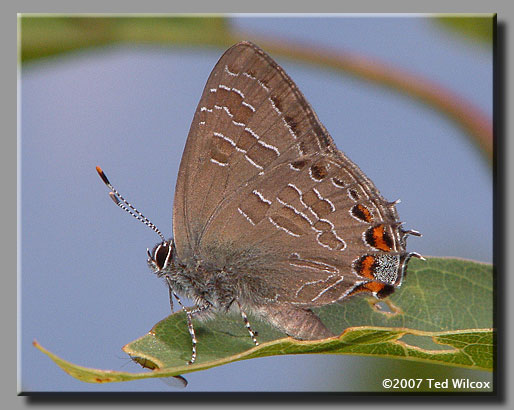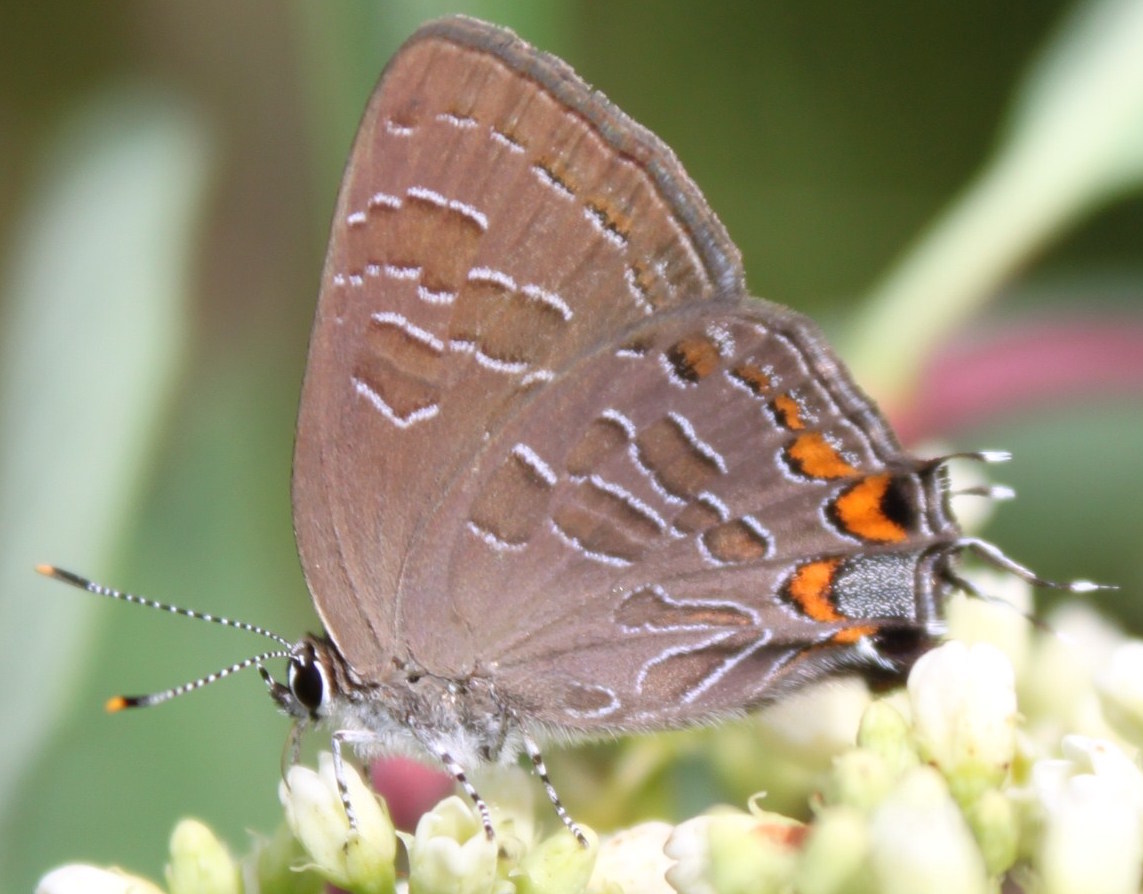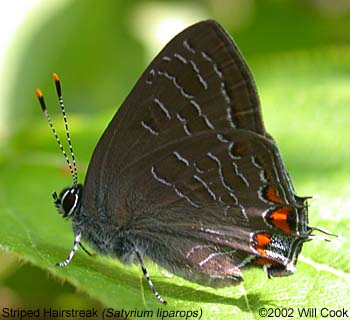|
| Common Name | Striped Hairstreak by Ted Wilcox => 07/03/06 - Ashe County, NC - male
[View PDF]
 Click to enlarge Click to enlarge
[Google Images] GBIF [Global Distribution ] BoA [Images ] iNaturalist |
| Scientific Name | Satyrium liparops
|
| Link to BAMONA species account. |
| Map | Click on a county for list of all database records for the species in that county.
 |
| Distribution | DISTRIBUTION: Scattered over the entire state, but many gaps in the range are present. These gaps are undoubtedly due to its very low numbers across the state and not to differences in real "abundance".
|
| Abundance | ABUNDANCE: Rare over most of the state; most numerous in the lower Coastal Plain. Locally uncommon in the lower Coastal Plain and along the Outer Banks; surprisingly numerous in the Great Dismal Swamp. Very rare in most of the Piedmont.
|
| Flight | FLIGHT PERIOD: A single brood. The flight in the Coastal Plain and Piedmont occurs from mid-May to late June, rarely to early July; but in the Mountains it is on the wing mostly from the end of May to late July. Except for the Oak Hairstreak, it flies slightly earlier than the other Satyrium species in NC, perhaps by about five days.
|
| Habitat | HABITAT: Very wide range of habitats, but usually near edges or openings of hardwood forests, especially those with an abundance of highbush blueberries (Vaccinium spp.). Occurs both in upland habitats and in wetland forests; in the Coastal Plain, it favors wetland forest openings and edges (particularly near stands of highbush blueberries). In the Mountains, Striped Hairstreaks have been seen at mountaintop openings, with other hairstreaks. It tends to stay closer to forests than other Satyrium species.
|
|
| | Plants | FOOD AND NECTAR PLANTS: The foodplants are mostly cherries (Prunus spp.), plums (also Prunus spp.), and blueberries; in other words, a variety of shrubs and trees in the rose (Rosaceae) and heath (Ericaceae) families. The species nectars on many flowers, such as milkweeds (Asclepias spp.), Indian-hemp (Apocynum cannabinum), etc. In the Dismal Swamp, I found it quite common in 1994. Most nectared on Indian-hemp. I suspect that highbush blueberries (Vaccinium formosum and others) are a (or the) foodplant; this plant was common not only there but at a site in New Jersey were I saw 20 individuals in one hour in 1994.
|
| Comments | COMMENTS: Why this species is so seemingly scarce in NC is a mystery. It has such a supposedly wide choice of foodplants and habitats that purposefully searching for it, other than in Dismal Swamp, is difficult. I saw up to 30 in a day in the Dismal Swamp from mid-May to early June 1994. At both this site and the New Jersey site, the hardwood forests were moist, highbush blueberries were abundant, and the woods were bisected by narrow dirt roads. I was fortunate to find the species on six occasions in 1995, from Mount Jefferson to Crowders Mountain to the Sandhills to Holly Shelter. In nearly all cases, however, sightings were unexpected. Despite thousands of hours of coverage by butterfliers in the state in 1999 and 2000, just a single Striped Hairstreak was reported, further emphasizing its rarity in North Carolina. We received five reports in 2001, better than for the two previous years, but still a paltry number considering the fair amount of field work done across the state and the potential for the species to occur in any county. Gratifyingly, observers found the species in three new counties in 2002, filling gaps in the central Mountains and finally found in the heavily-worked Wake County. In most years, only a few sightings (at most) are made; however, in 2019, observers documented the species in an excellent four new counties (Bertie, Bladen, Hyde, and Stokes). To find this species, be afield often from mid- or late May to mid-June (and in July in the Mountains)!
|
State Rank | S3S4 | | State Status | |
Global Rank | G5 | | Federal Status | |
| Synonym |
|
| Other Name |
|
|
|

 >>
>>
